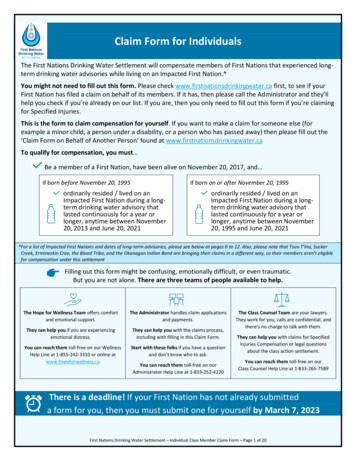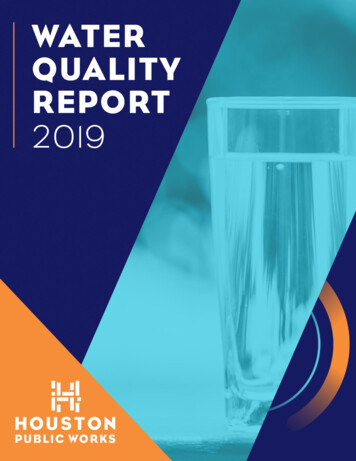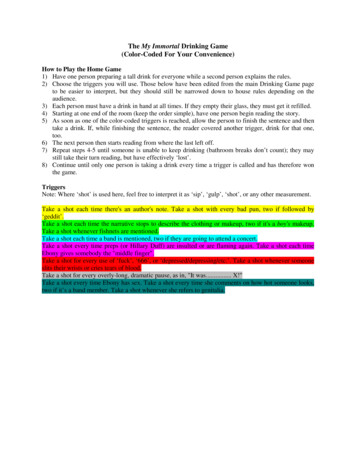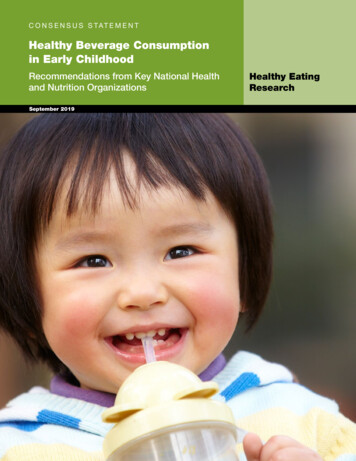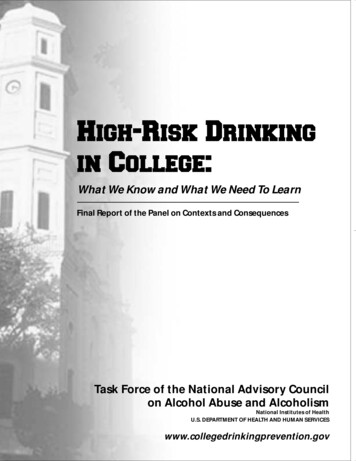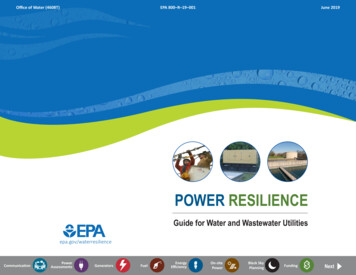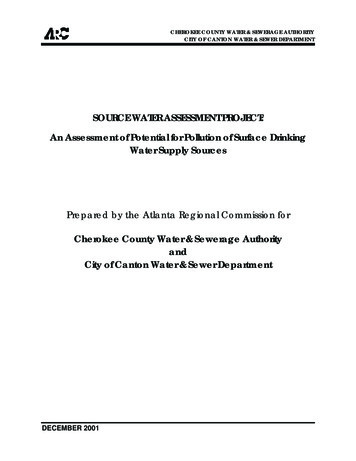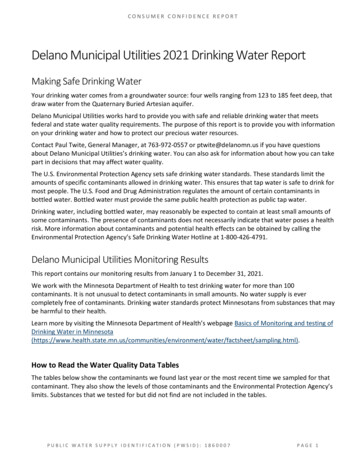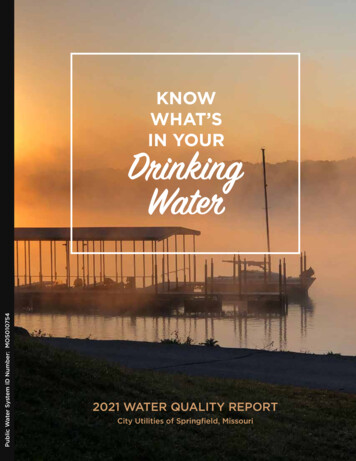
Transcription
KNOWWHAT’SIN YOURPublic Water System ID Number: MO5010754DrinkingWater2021 WATER QUALITY REPORTCity Utilities of Springfield, Missouri
Table of ContentsDirectors Award. 3Watershed Stewardship at Fellows Lake. 6Where Your Water Comes From. 7About Our Watershed. 8Important Drinking Water Definitions. 9Water Quality Summary. 10Unregulated Contaminant Monitoring.13Water at a Glance.14How Your Water is Treated.15Water Savings Tips.171I WATER QUALITY REPORT
2021 I2
This report contains important information about Springfield’s drinking water.For more information regarding this assessment or for additional water quality data,call the City Utilities Manager-Water Quality Lab at 417-831-8822.For the 22nd year in a row, City Utilities of Springfield’s Blackman andFulbright Water Treatment Plants have received the Directors Award fromthe Partnership for Safe Water, a program of the American Water WorksAssociation (AWWA). This award is given in recognition of the efforts toachieve excellence in water quality far beyond what is required by federalregulations. Less than one percent of the treatment plants in the UnitedStates have received this recognition.3I WATER QUALITY REPORT
Water is important for all life.While City Utilities provides water,natural gas, electricity, transit,and broadband services to theCity of Springfield—water is theonly commodity that our customersingest. Providing safe drinking wateris not an option, but is a necessity tokeep our community healthy.City Utilities’ commitment to you,our neighbor, is that our team willcontinue to work hard every dayto ensure you not only have safedrinking water, but great tastingwater too.ATTENTIONLandlords andApartment Owners:Please share a copyof this report with yourtenants about thequality of theirdrinking water.2021 I4
5I WATER QUALITY REPORT
at Fellows to expand on a long and productivepartnership with City Utilities to help peopleconnect and “protect”.What about the other 99 percent of our drinkingwater catchment-mostly rural/agricultural-that isprivately owned? The intersection of everythingwe’ve learned so far is that producers are not ourbiggest challenge, they are our best opportunity!With a few key practices like implementing riparianbuffers and rotational grazing, producers canrealize increased productivity while improvingrunoff water quality, as well as absorption intothe soils and aquifer. The Little Sac GrazingDemonstration, located on CU property just belowFellows Lake, serves as an outdoor classroom forpartners to showcase this regenerative transition.FELLOWS LAKE SEES NEW RECREATIONWITH WATER QUALITY TOP-OF-MINDWATERSHED STEWARDSHIP ATFELLOWS LAKE AND BEYONDMike Kromrey, Executive Director, WatershedCommittee of the OzarksWe can’t make it rain. Over 99 percent of thewatersheds that collect our drinking water areprivately owned. Our population in southwestMissouri is growing, and weather and long-termclimate trends are uncertain. Few things are asimportant as providing clean, safe, affordabledrinking water; few things are as easy to overlookbecause of a job well done. Keeping up the goodwork for years to come will require long-termvision, planning, and building on our currentsuccess with urgency. Fellows Lake provides thetesting ground and template for future efforts.Keeping Fellows Lake clean has always been,and always will be, paramount. How we recreatearound clean water can take different forms,and the current plans mark a shift in strategy:from focus on protection through restriction, toa focus on engagement and stewardship. Lowimpact “silent sports,” like hiking, cycling, running,paddling, fishing, hunting, bird watching even kiteflying, provide the chance to share the resource,build community, and engage patrons witheducation and stewardship. As the venerable quoteby Baba Dioum states: “In the end we will conserveonly what we love; we will love only what weunderstand; and we will understand only what weare taught.” In 2021, Watershed Committee of theOzarks (WCO) signed on as a community partnerFellows Lake is quickly becoming a recreationaldestination for the area-with biking, boating,fishing, and hiking opportunities in abundance, andmore exciting things on the horizon. The strongpartnership between City Utilities of Springfield,Ozarks Greenways, the Watershed Committee ofthe Ozarks, and TrailSpring has helped provideand grow the vision for the area.These partner initiatives have enhanced thearea, while placing a high priority on the role ofthe lake’s water to the community.“In the endwe will conserveonly what welove; we will loveonly what weunderstand; and wewill understandonly what weare taught.”2021 I6
WHERE YOUR WATERCOMES FROMCity Utilities’ drinking water comes from a variety of lakes, rivers, wells, and a spring. Approximately74 percent of Springfield’s drinking water comes from surface waters, such as lakes and rivers. Theremaining comes from groundwater wells and a spring.City Utilities’ Fulbright and Blackman Water Treatment Plants use a combination of sources forwater treatment, including both surface and groundwater. Fulbright is located on the northern edgeof Springfield and is served by Fulbright Spring (the original source for the city), a deep well, andMcDaniel Lake. The Blackman Plant is in the southeastern corner of the city and receives water fromFellows Lake and James River. Both Fellows and McDaniel Lakes can be supplemented with waterfrom Stockton Lake. Another deep well can be found in the distribution system and is used as anadditional source when needed.7I WATER QUALITY REPORT
St ClairCamdenHickoryABOUT OUR WATERSHED The cleaner our sources of drinking water,the better it will taste and smell, less it willcost, and more affordable it will be for theconsumers.elin Nutrients from fertilizer, animal or humanwaste, and sediment from erosion can causealgae blooms in our drinking water reservoirswhich can negatively impact our water supply.pePi Prescribed or rotational grazing practices helpimprove soil health and water quality, whileover- grazed pastures do the opposite.PolkStocktonLakeeratW The “riparian area” is the land along streamsand rivers. Forested riparian areas are oneof the best ways to prevent flood damage,erosion, and nutrient pollution to ourdrinking water.DallasStockton LakeWatershedw The wells in Springfield come from the aquiferwhich are replenished by precipitation soakinginto the ground. Healthy soils increase thequality and quantity of water that rechargesthe aquifer.CedarRaSpringfield is fortunate to have a variety ofnatural resources available to supply ourcommunity’s drinking water. Springfield’swater sources are unique compared to othercommunities in southwest Missouri. While othertowns and rural residents rely on groundwaterwells, customers of City Utilities have anabundance of surface water sources.DadeGreeneMcDaniel LakeWatershedMcDanielLakeFulbright SpringRecharge AreaFellows Lake renceSpringfieldJames RiverWatershedSpringfieldLakeChristianSOURCE WATER ASSESSMENTThe Department of Natural Resourcescompleted a source water assessment forCity Utilities’ drinking water sources. Theassessment showed that, as expected forsurface waters, the sources are susceptible toviruses and microbiological contaminants, whichare inactivated by conventional treatment. Inaddition, all surface waters are moderatelysusceptible to land-use activities within thewatershed. City Utilities, in support of theWatershed Committee of the Ozarks, willcontinue to encourage low-impact land useto reduce detrimental effects to our drinkingwater sources. The source water assessmentfor our system can be found online at http://drinkingwater.missouri.edu. City Utilities’ PublicWater System number is 5010754.2021 I8
IMPORTANT DRINKING WATER DEFINITIONS90th percentile: For lead and copper testing.10% of test results are above this level and 90%are below this level.Action Level (AL): The concentration of acontaminant which, if exceeded, triggersrequirements which a water system must follow.HAA5: Haloacetic acids (mono-, di-, andtri-chloroacetic acid, and mono- anddi-bromoacetic acid) as a group.Locational Running Annual Average (LRAA):The average of samples collected at a particularlocation, calculated from the most recent4 quarters.Maximum Contaminant Level (MCL): Thehighest level of a contaminant that is allowedin drinking water. MCLs are set as close to theMCLGs as feasible using the best availabletreatment technology.Maximum Residual Disinfectant Level Goal(MRDLG): The level of a drinking waterdisinfectant below which there is no knownor expected risk to health. MRDLGs do notreflect the benefits of disinfectant use to controlmicrobial contamination.Nephelometric Turbidity Units (NTU): Ameasure of cloudiness of the waterPopulation: 172,025. This is the equivalentresidential population served including non-billpaying customers.Range of Results: Shows the lowest and highestlevels found during a testing period. If only onesample was taken, then this numberequals the highest test result or highest value.Running Annual Average (RAA): The averageof sample analytical results for samples takenduring the previous four calendar quarters.Maximum Contaminant Level Goal (MCLG): Thelevel of a contaminant in drinking water belowwhich there is no known or expected health risk.MCLGs allow for a margin of safety.Total Trihalomethanes (TTHM):Total trihalomethanes (chloroform,bromodichloromethane, dibromochloromethane,and bromoform) as a group.Maximum Residual Disinfectant Level (MRDL):The highest level of a disinfectant allowed indrinking water. There is convincing evidence thataddition of a disinfectant is necessary for controlof microbial contaminants.Treatment Technique (TT): A required processintended to reduce the level of a contaminantin drinking water.Turbidity: A measure of the cloudiness orclarity of water. It is monitored because it is agood indicator of both water quality and theeffectiveness of our filtration system.UNIT DESCRIPTIONS & DEFINITIONSGrains Per Gallon (GPG):measure of hardness 1 GPG 17.1 ppmMEASUREMENTSParts Per Million (ppm):or milligrams per liter (mg/L)Parts Per Billion (ppb):or micrograms per liter (ug/L)Not Detected (ND):not detectable at testing limitsN/A:not applicable9I WATER QUALITY REPORTParts Per Million1 drop in a 10-gallonfish tankParts Per Billion1 drop in a 10,000-gallonswimming pool
CITY UTILITIES OF SPRINGFIELD - WATER QUALITY SUMMARY 2021DetectedContaminantsUnitsMCLGMCLRangeAverage LevelDetectedComplianceMajor SourcesND ( 0.10) 0.420.96YESAdded during treatment for dentalhealth or dissolvedfrom natural deposits1.42YESTreatment PlantsFluorideppmTotal LN/ATT: 0N/ATT: at least95%of samples 0.3 NTUTotal OrganicCarbonTurbidityNTU444 (MRDLG) 4 (MRDL)0.76 - 2.580.0472 0.05980.0689YESND ( 0.05) 2.04YESND ( 0.01)1ND ( 0.01)YES0.80Water additive usedfor disinfectionDischarge of drillingwastes or from metalrefineries; erosion ofnatural depositsRunoff from fertilizer;leaching from septictanks or sewage;erosion ofnatural depositsRunoff from fertilizeruse; leaching fromseptic tanks, sewage;erosion ofnatural deposits0.71 - 2.53YESNaturally occurringHighest SingleMeasurement 0.12Percentage of samples 0.3 NTU 100%Fully Compliant - all 12 monthsYESSoil runoff1.492021 I10
DetectedContaminantsMCLGUnitsMCLRangeHighest LRAADetectedComplianceMajor SourcesDistribution SystemTotalTrihalomethanesppbN/A80 (LRAA)437.8 - 75YESHaloacetic AcidsppbN/A60 (LRAA)252.66 - 36.2YESLeadppb02019** Testing Results90thRangeAL 15PercentileDetectedValues 1.0 - 21.08.2Copperppm1.3AL 1.30coliformbacteria inno morethan 5% ofsamples%Total ColiformpositiveBacteriasamples0.0940.011 - 0.262021 testing - highestmonthly % positiveBy-product of drinkingwater disinfectionBy-product of drinkingwater disinfectionYESCorrosion ofhouseholdplumbing; erosion ofnatural depositsYESCorrosion of householdplumbing; erosion ofnatural depositsYESNaturally present in theenvironment - No fecalcoliform or E. coli in1,594 tests in 20211.43% OctoberAdditional Monitoring Data (General Water Quality Parameters)AnalyteUnitsAverageRangeGPG8.965.26 - 12ppm153.290 - 205.2HardnessCommentsMajor SourcesHardness refers to themineral content of water.Calcium and magnesiumare the main contributorsto water hardness.Erosion of naturaldepositsViolations and Health Effects InformationCompliance PeriodAnalyteNo Violations Occurred in the Calendar Year of 2021Type** System-wide testing of representative homes for lead and copper (which may be imparted to the water fromplumbing and fixtures) is conducted every three years, as required by the Environmental Protection Agency.The latest round of testing was conducted in 2019, with results presented here. The next round of testing willoccur in 2022.11I WATER QUALITY REPORT
2021 I12
UNREGULATED CONTAMINANT MONITORING RULE RESULTS - 2019UCMR4Detected ContaminantsCollection Date of HVHigh Value (HV)Range DetectedBromide08/20/1939.527.7 - 39.5HAA505/13/1942.285 - 42.28HAA6Br08/20/1919.886.1 - 19.88HAA905/13/1954.519.9 - 54.51Manganese02/04/190.530 - 0.53Total Organic Carbon05/13/1938801070 - 3880UnitppbppbppbppbppbppbUnregulated contaminants do not have a maximum contaminant level (MCL) associated with their occurrence.Utilities are periodically required to sample for unregulated contaminants to assist EPA in determining if an MCL isneeded for those contaminants. During the latest round of monitoring our utility tested for 30 contaminants - the6 contaminants measured at detectable levels are listed in the table (ABOVE).WHAT ARE THE SOURCES OFCONTAMINANTS?As water travels over the land’s surface orthrough the ground, it dissolves naturallyoccurring minerals and, in some cases, radioactivematerial, and can be polluted by animals orhuman activity. Contaminants that might beexpected in untreated water include microbialcontaminants, such as viruses and bacteria;inorganic contaminants, such as salts and metals;13I WATER QUALITY REPORTorganic chemicals from pesticides, herbicides,and industrial or petroleum use; and radioactivematerials. Drinking water, including bottledwater, may reasonably be expected to contain atleast small amounts of some contaminants. Thepresence of contaminants does not necessarilyindicate that water poses a health risk. Moreinformation about contaminants and potentialhealth effects can be obtained by calling theENVIRONMENTAL PROTECTION AGENCY’S SAFEDRINKING WATER HOTLINE: 800-426-4791.
SPECIAL HEALTH INFORMATIONSome people may be more vulnerable to certaintypes of contamination in drinking water thanthe general population. Immuno-compromisedindividuals, people with cancer who areundergoing chemotherapy, people who haveundergone organ transplants, people with HIV/AIDS or other immune system disorders, someelderly persons, and infants can be particularlyat risk for infections. These people shouldseek advice from their healthcare provider.Environmental Protection Agency and Centers forDisease Control guidelines on appropriate meansto lessen the risk of infection by Cryptosporidiumand other microbial contaminants are availablefrom the EPA hotline listed below:WATER AT A GLANCEABOUT LEAD AND COPPERCity Utilities fully complies with the lead andcopper provisions of the Safe Drinking Water Act.In 2019, City Utilities gathered samples from anumber of residences in accordance with state andfederal regulations. EPA regulations require thatat least 90 percent of the samples are below theaction level for both lead (15 ppb) and copper (1.3ppm). Of the 55 residences sampled in 2019, twoof the results exceeded the action level for eitherlead or copper.Environmental ProtectionAgency’s Safe Drinking WaterHotline: 800-426-4791Special Lead and Copper Notice: If present,elevated levels of lead can cause serious healthproblems, especially for pregnant women andyoung children. Lead in drinking water is primarilyfrom materials and components associated withservice lines and home plumbing. CU is responsiblefor providing high quality drinking water butcannot control the variety of materials used inplumbing components. When your water has beensitting for several hours, you can minimize thepotential for lead exposure by flushing your tapfor 30 seconds to 2 minutes before using waterfor drinking or cooking. If you are concernedabout lead in your water, you may wish to haveyour water tested. Information on lead in drinkingwater, testing methods, and steps you can taketo minimize exposure is available from the SafeDrinking Water Hotline (800-426-4791) or r/basic-information-about-lead-drinking-water.2021 I14
HOW YOUR WATCity Utilities takes great measures toyou and your family to drink. This pCOAGULANCOAGULANTSRaw water is drthe BlackmaTreatment Plants.is mixed with thecauses small partforming largCORROSIONCONTROLWATERCONSUMPTION15I WATER QUALITY REPORTTREATED WATERSTORAGEChlorine is thenany bacteria, viruseIn addition, caWhile fluorideadded to help pradjusted to protplace before tyour home, or athe qualityan
TER IS TREATEDo keep your water clean and safe forprocess takes place in four steps:SEDIMENTATIONNTS/FLOCCULATIONrawn into mixing basins atan and Fulbright Water. During this step, coagulante raw water. This processticles to stick to each other,ger particles called floc.FLUORIDENext, the particles slowly become heavier andsettle to the bottom of a basin. This is howmost of the dirt and contaminants areremoved from the water.DISINFECTIONDISINFECTIONn added and given plenty of time to inactivatees, or other harmful microbes that might remain.arbon is used to help the water taste great.e occurs naturally in water, a small amount isrotect oral health. Finally, the pH of the water istect pipes from corrosion. All these steps takethe water goes into the distribution system,any business. City Utilities carefully monitorsy of water during the treatment processnd throughout the water system.FILTRATIONTo finish the clarifying of the water,it is then filtered through layers of fine,granulated materials consisting of carbon,sand, and rocks. As smaller particles areremoved, cloudiness diminishes, andclear water emerges.2021 I16
10 WAYS TO SAVE WATER AT HOME1. Check your faucet and pipes for leaks.2. Plant flowers that require less water.3. Water your yard and outdoor plantsearly or late in the day to reduceevaporation.4. Only run the washing machine and dishwasher when you have full loads.5. Install a rain barrel for outdoor watering.6. Use a broom to clean driveways ratherthan a hose.7. Limit your shower time.8. Turn off water while brushing your teeth.9. Use a wash basin to wash fruits andvegetables.10. Fix dripping pipes, faucets, and hoses.Visit cityutilities.net to see rebates offeredby City Utilities to help you save even more!City Utilities Water Plant Operators workaround the clock monitoring City Utilities’ watertreatment process, facilities, and water sources.Fulbright Water Treatment Plant was constructed in 1940 and is an American Water WorksAssociation Landmark site. Today, the plant provides Springfield with nearly 21 million gallons of watereach day.17I WATER QUALITY REPORT
retaWsrebNumby theEVEN or ODD WATERING SCHEDULECity Utilities is committed to helping our customers use their water and energywisely. With your help, Springfield may be able to save 5 million gallonsof water every day with the Even-Odd Watering Schedule.Lawns in our area typically need 1 to 1.5 inches of water per week toremain green. You can achieve this goal and help our community savewater. If your house number ends in an even number, water onlyWednesday, Friday, and Sunday. If your house ends withan odd number, water on Tuesday, Thursday, andSaturday. On Monday’s, we will all take a break.2340Finding out is as simple aslooking at your address.EVEN HouseNumbers Water2341ODD HouseNumbers WaterFor more information about the Even-Odd watering program and how you can savewater, call 417-874-8200 or visit cityutilities.net.2021I18
301 East Central, P.O. Box 551 Springfield, Missouri 65801cityutilities.net
call the City Utilities Manager-Water Quality Lab at 417-831-8822. For the 22nd year in a row, City Utilities of Springfield's Blackman and Fulbright Water Treatment Plants have received the Directors Award from the Partnership for Safe Water, a program of the American Water Works Association (AWWA).
